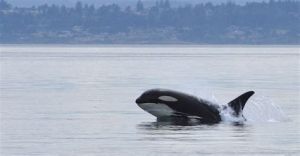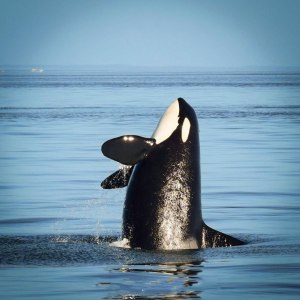
Since Obama took office, 15 animal and plant species have been removed from the endangered species list, more than the total combined number of species removed under all previous administrations since the Endangered Species Act became active in 1973. These include the Louisiana black bear, the Virginia northern flying squirrel, and the Lake Erie water snake, and Brian Hires, a public affairs officer with the U.S. Fish and Wildlife Service (USFWS) believes several more species could be removed from the list, which currently numbers 2000, before the next president is sworn in this January, from the Hawaiian hawk and Gray wolf to certain Humpback whale populations.
However, many species continue to be newly added to the endangered species list, with help from groups like the Center for Biological Diversity and WildEarth Guardians, who regularly litigate the government when severely threatened animals remain unprotected for years or decades. Brett Hartl, endangered species policy director for the wildlife protection nonprofit Center for Biological Diversity says his group sues when the USFWS does nothing to save imperiled species from plights such as trafficking, climate change, and habitat destruction: “If the Service were to complete its mandates on time and proactively protect species at the verge of extinction, we would not have to sue them repeatedly. They hold their own destiny in their hands.”
Nevertheless, conservative lawmakers have worked to make it easier to delist endangered or threatened species in order to appease various groups, from ranchers and farmers to fossil fuel industry companie, who feel the ESA wildlife conservation efforts they would need to undertake would eat into their profits. Attempting to resolve these conflicts, the Obama administration has negotiated several agreements for landowners to merely volunteer to preserve endangered animals on their land, allowing them to bypass the ESA’s stricter preservation policies.
Hires notes that delisting species is a complex process, as many of the species in question inhabit both private and public lands, often crossing state and even international borders. “Successfully preventing the extinction of a species and recovering it so it no longer requires the ESA is a real team effort,” he says. “It requires intensive coordination and collaborations with state wildlife agencies, private landowners, conservation groups, industry, other federal agencies, and more.” For a species to be removed from ESA protections, the USFWS first examines the current state its habitat, likelihood of disease or predation, and other natural or manmade factors, and then decides whether the species would be able to successfully survive in the wild.
Hires also says that climate change will require conservationists to rethink the way they have traditionally managed endangered species, perhaps by focusing on preserving entire landscapes and ecosystems rather than specific species. “Impacts of climate change include increased size and number of wildfires, insect outbreaks, pathogens, disease outbreaks, and tree mortality,” said Hires. Rising sea levels and temperatures, as well as extreme weather associated with climate change will likely have big impacts on conservation efforts.
Hartl believes that most of the approximately 60 delisted species have fared well “because state management is done in good faith and the species are still protected in a science-based fashion. It only falls apart when states act in bad faith,” he said. “Wolves are a good example—as soon as ESA protections were lifted in Montana and Idaho, wolf populations were reduced due to unregulated hunting and trapping.”
Recently, the USFWS announcement that grizzly bears around Yellowstone National Park could be delisted led to controversy. The proposal would transfer grizzly management to states surrounding the park and would likely initiate grizzly bear hunting seasons. The Yellowstone population has grown from 136 animals to between 700 and 1000 since the species’ inclusion on the endangered list in 1975. However, groups like the Humane Society feel that Yellowstone grizzly bears “are far from recovered.” Humane Society’s President & CEO Wayne Pacelle notes that human-caused grizzly mortality rates are up and that the “bears are facing a range of threats to critical food sources, including white bark pine nuts and lake trout.”

Similarly, for years wildlife groups have argued over the status of the greater sage-grouse, an imperiled bird whose natural habitat cuts across central states whose economies rely heavily on fossil fuel production. In May the oil and gas industry challenged drilling restrictions imposed by the Obama administration to protect the sage-grouse, even though the current restrictions are still a compromise from more stringent ESA rules. Says Hartl of the complex and often politicized conflicts that conservation efforts can spark, “Questions about when to protect species must be based solely on science in order to avoid parties trying to game the system, at the expense of species themselves.”
Regarding the 15 delistings under Obama, Hartl said “it is a victory and credit goes to the heroic efforts over the last 30 years. It is not the achievement of the Obama administration alone because these successes took years to build up to.”
Source: Phillips, Ari. “The convoluted life of an endangered species—and why more are being saved now than ever.” Fusion. 19 May 2016.

Wildlife Conservation Film Festival
Biodiversity & Wildlife Crime Conference
Christopher J. Gervais, F.R.G.S.
Founder & CEO
Christopher@WCFF.org
http://www.WCFF.org
Facebook.com/WCFForg
Twitter: @WCFF_org
Twitter: @CJGERVAIS
Instagram: @wcff_org
Vimeo.com/wcff
dailymotion.com/WCFF1
LinkedIn: Wildlife Conservation Film Festival














 M’Pai Bai jetty with school of fish. Photo by Paul Colley / Fauna & Flora International.
M’Pai Bai jetty with school of fish. Photo by Paul Colley / Fauna & Flora International. Blue-spotted ray. Photo by Paul Colley / Fauna & Flora International.
Blue-spotted ray. Photo by Paul Colley / Fauna & Flora International. Flabellina nudibranch, a colorful sea slug. Photo by Paul Colley / Fauna & Flora International.
Flabellina nudibranch, a colorful sea slug. Photo by Paul Colley / Fauna & Flora International.







